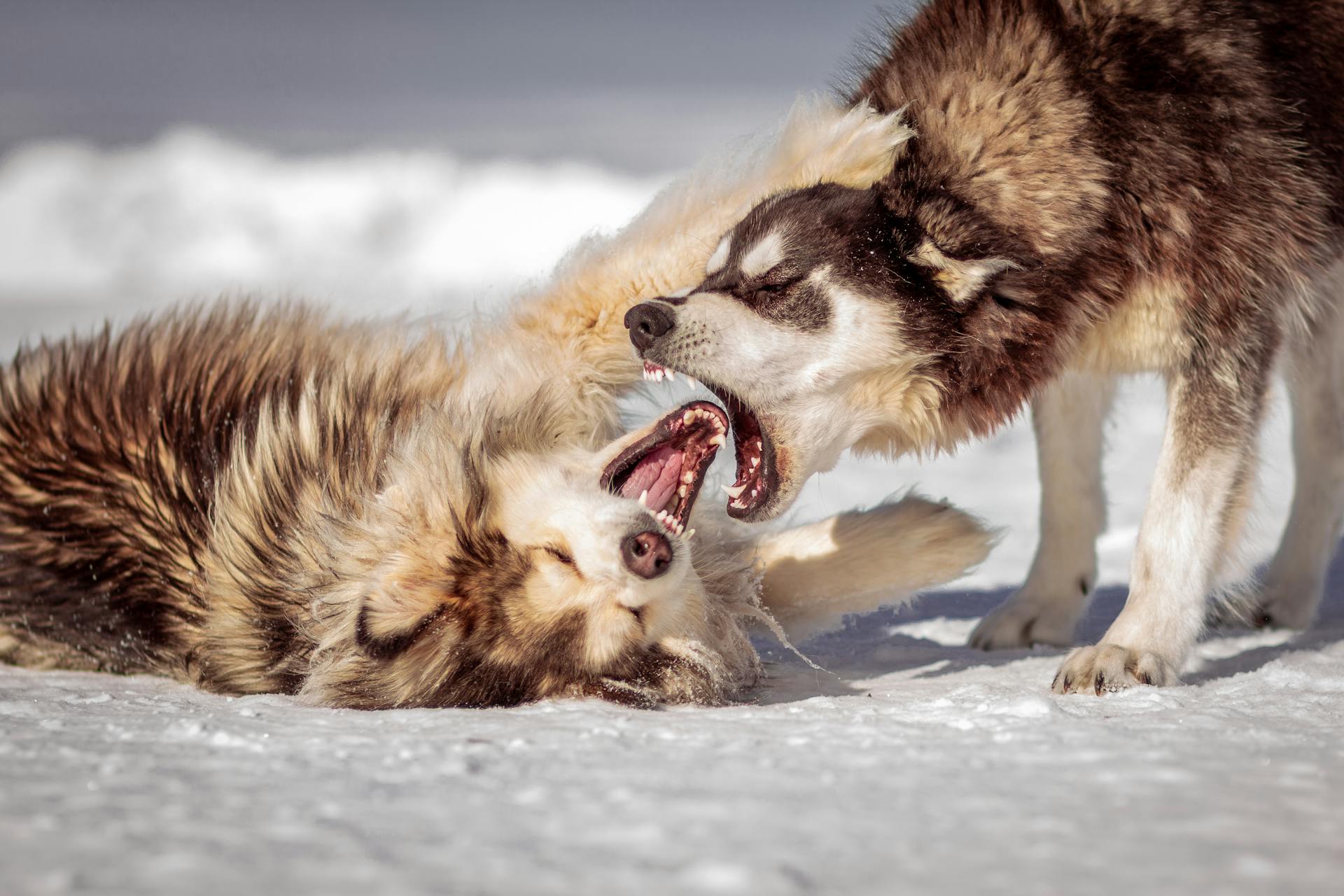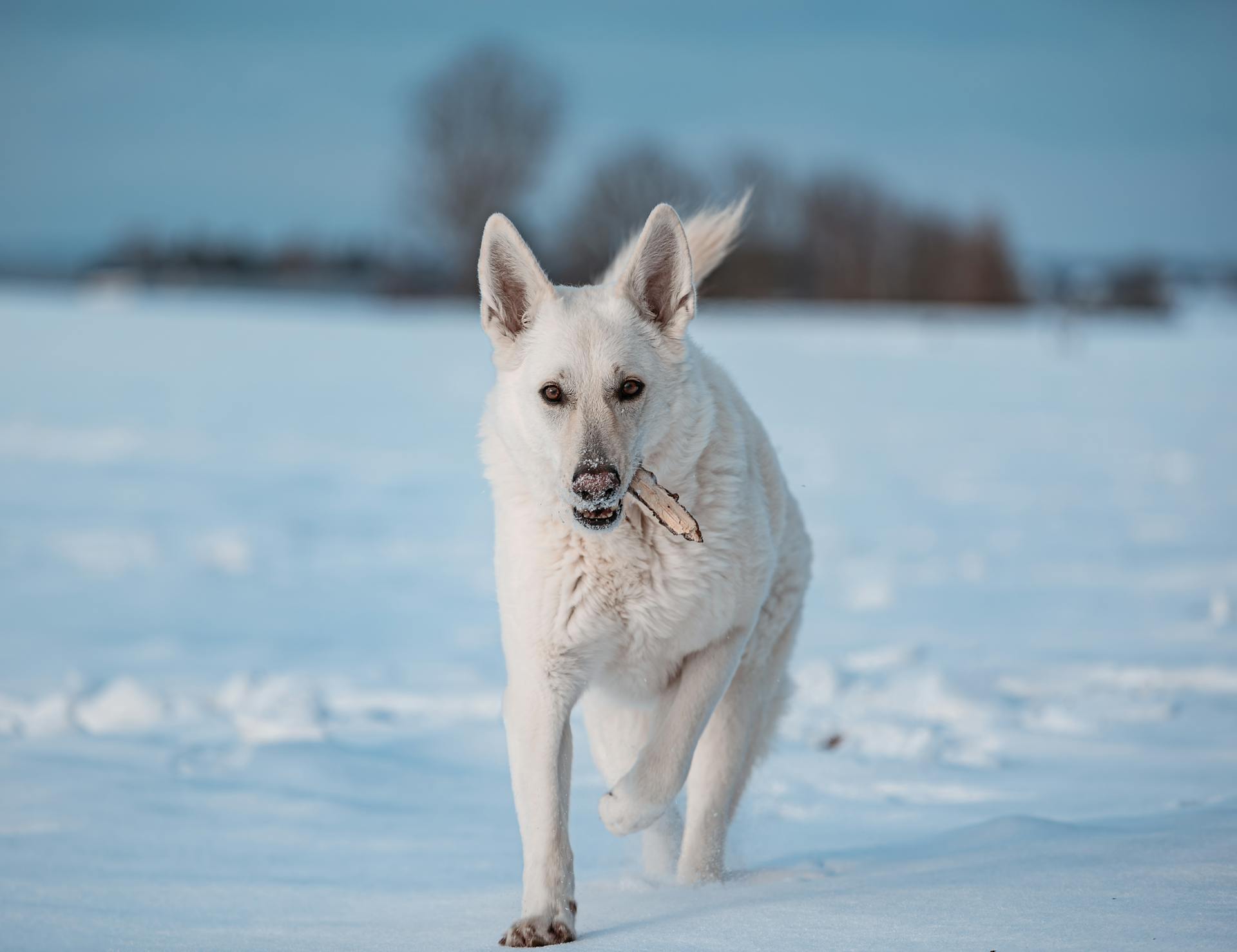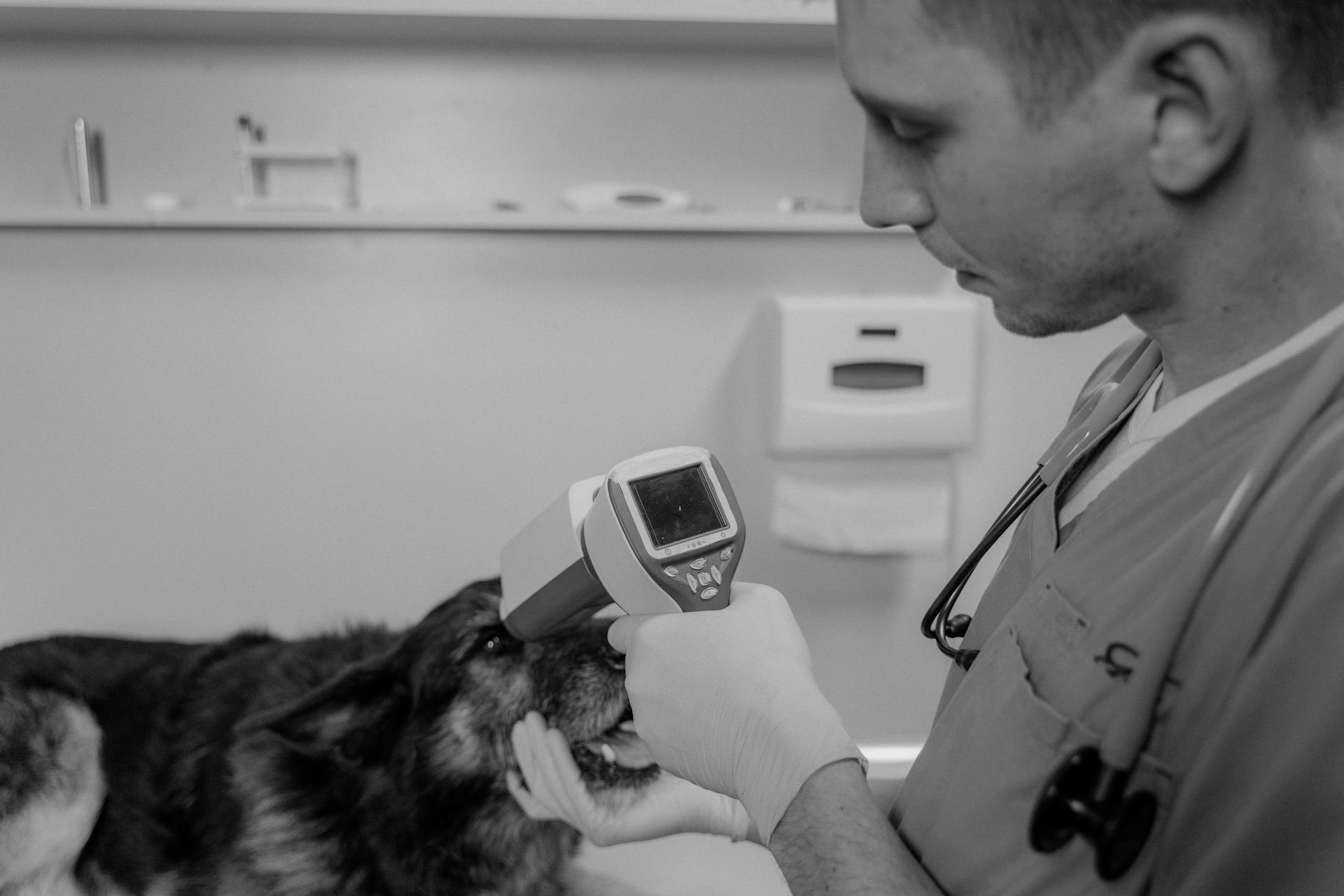
Dog anti-social behaviour can be a frustrating and concerning issue for many dog owners. According to research, approximately 25% of dogs exhibit unwanted behaviours such as barking, chewing, and digging.
These behaviours can be caused by a variety of factors, including boredom, anxiety, and lack of exercise. In fact, studies have shown that dogs who receive less than 30 minutes of exercise per day are more likely to develop unwanted behaviours.
Understanding the underlying causes of your dog's behaviour is crucial in managing and addressing the issue. By identifying the root cause, you can develop a plan to address it and help your dog become a well-behaved member of the family.
Signs of Anti-Social Behaviour
Dogs that bark excessively, especially when there's no apparent reason, may be exhibiting antisocial behaviour.
Persistent barking is one of the most common signs of antisocial behaviour in dogs.
Aggression towards people or other animals is another sign, which can manifest as growling, snapping, or biting.
Chewing on furniture or other objects, digging holes, and escaping from the yard are also common signs of antisocial behaviour.
Some dogs may not respect human spaces, getting too excited when guests arrive or tugging at the leash during walks.
A dog's antisocial behaviour can be rooted in fear or anxiety, protectiveness, or territoriality, making it essential to work with a qualified trainer or behaviourist to identify the root cause.
Recognizing signs of fearful or stressed behaviour in dogs is crucial, and some common signs include avoiding people, pets, or places, cowering behind their owners, or showing stress when experiencing new things.
Antisocial dogs may also try to avoid people or dogs who aren't familiar to them, and some may even become aggressive due to their fear.
Curious to learn more? Check out: Dog Behaviour When Owner Pregnant
Causes of Anti-Social Behaviour
Insufficient socialization is a common cause of anti-social behavior in dogs.
If a puppy isn't given the opportunity to be exposed to many different people and situations during the critical period of development, they may become fearful or anxious around people and other dogs.
Stress, health problems, and past experiences can also contribute to anti-social behavior.
Dogs that bark excessively, especially when there is no apparent reason, may be exhibiting anti-social behavior.
Aggression towards people or other animals is another sign of anti-social behavior, which can manifest as growling, snapping, or biting.
Chewing on furniture or other objects, digging holes, and escaping from the yard are also common signs of anti-social behavior.
Inadequate socialization during the critical period of development can lead to aggression due to fear or anxiety.
Some breeds are more prone to aggression due to genetics.
Prior bad experiences, such as being abused or neglected, can also cause anti-social behavior.
Health problems, like pain or illness, can make even the sweetest dog grumpy and aggressive.
If this caught your attention, see: Social Anxiety Dog Training
Preventing Anti-Social Behaviour
Puppies learn about the world through their mother and littermates, but it's up to you to help them grow up to be well-rounded.
Introducing your puppy to new situations, people, and other dogs between three weeks and four months of age is key to preventing antisocial behavior. This is the most effective time for socialization.
Socialization helps puppies learn to cope with new situations, animals, and people as adults. It's never too late to socialize a dog, even if you adopted them as an adult.
To prevent antisocial behavior, you should take your puppy out to places where there are a few dogs, but avoid the dog park. This can be overwhelming for your puppy.
Consider a playdate or doggy daycare instead, where your puppy can make friends with calm and friendly dogs. This is a good start for introducing multiple dogs to your puppy.
Introducing your puppy to new dogs and people should be done slowly and on their terms. Let them set the pace and progress may be slow, but it's worth sticking with it.
Use a quiet, neutral place for introductions and keep both dogs on leashes. Make sure you're using positive reinforcement and keeping sessions short.
Here's an interesting read: 6 Month Old Puppy Resource Guarding
Addressing Anti-Social Behaviour
If your dog is afraid to mix with other dogs, start off by helping him make friends with other dogs of the same size, giving him a chance to socialise without feeling anxious or overwhelmed.
To do this, try to find calm dogs that will not make your anti-social dog anxious, and with patience and time, your dog will learn to enjoy being around other dogs and will be less fearful.
Using healthy training treats is a great way to teach your dog to stay calm and well-behaved when strangers come into your home. This can help your dog associate strangers with something positive, like getting a tasty treat.
To train your dog to 'stay' when visitors come over, have them drop a treat on the floor near your dog as they walk in. With a little patience and consistency, you should be able to train your anti-social dog to stay calm and collected around strangers.
Taming aggressive behaviour during walks requires patience and the right approach. One way to do this is to avoid letting your dog get overwhelmed, which can lead to disastrous situations like barking excessively, lunging at people or other dogs, and generally being a nuisance.
Recommended read: Are Dogs Social Animals
Understanding Your Pet
Understanding your dog's body language is crucial in assessing their reactions and emotions, as it can differ from humans.
Dogs have distinct body language cues that indicate their feelings, such as cowering, rolling over, avoiding eye contact, or tucking the tail between the legs, which may indicate fearful or anxious behavior.
By learning to recognize these cues, you can better understand how your dog is reacting to a situation and take steps to address any antisocial behavior.
Worth a look: Dog Body Language with Other Dogs
Assessing Your Pet's Social Nature
Understanding your dog's history is crucial when adopting an adult or rescued pup. You need to know about their past struggles and behavioral issues to effectively re-condition them to exhibit healthy, social behavior.
Dogs that have been abused or lived in competitive environments may display fearful, anti-social behavior or dominating or aggressive tendencies. Knowing a dog's lived experiences helps you avoid triggers and give them the time and space they need.
For another approach, see: Why Does My Male Dog Lick My Female Dogs Pee
Recognizing your dog's body language is key to understanding their reactions and emotions. Dogs have distinct body language cues that differ from humans, such as cowering, rolling over, avoiding eye contact, or tucking their tail between their legs.
Adequate socialization as a puppy helps them learn to cope with new situations, animals, and people as an adult. If you adopted your dog when they were an adult, you can still work on socializing them and helping them overcome their fears or anxiety about new situations.
Breed Psychology Facts
Some dog breeds have been bred for aggression, which can lead to antisocial behavior. For example, the American Pit Bull Terrier, Staffordshire Bull Terrier, and Rottweiler were originally bred for fighting.
Pit bulls were bred for bull-baiting, a sport in which dogs fought bulls, contributing to their history of aggression.
Border collies are known for being very intelligent and active, while beagles are known for being friendly and laid-back, reflecting their temperamentally different personalities.
Any dog, regardless of breed, can exhibit excessive antisocial behavior if it hasn't been properly socialized or trained.
Managing Specific Behaviours
Helping your dog make friends with other dogs is key to addressing anti-social behaviour. Start by introducing them to calm dogs of the same size, and gradually increase interactions with other dogs and situations.
Dogs who are afraid to mingle with other dogs may become anxious or overwhelmed if introduced to too many new dogs at once. Finding calm dogs to socialise with is crucial.
To help your over-excited dog behave when strangers arrive, use healthy training treats to associate strangers with positive experiences. Give your dog a treat while they're petting him to help them stay calm.
A common sign of an anti-social dog is aggression, which can be shown through body language or actions like snapping, growling, or lunging at other dogs or people. Recognise the warnings signs of anxious or fearful behaviour before they start snapping and snarling.
Pulling on the leash is a common behaviour in anti-social dogs, often caused by excitement or reaction to strangers or other dogs. A relaxed dog will walk with you, but an anti-social dog will try to avoid interacting with people or be overexcited about saying "hi" to someone new.
Discover more: Boarding an Anxious Dog
Ways to Address Each Behaviour Type
Dogs who are afraid to mingle with other dogs can benefit from socialization with calm dogs of the same size.
To help your over excited dog behave when strangers arrive, use healthy training treats to associate strangers with positive experiences.
It's essential to start with small steps, such as having a stranger give your dog a treat while petting him, to help your dog stay calm.
You can also use this technique to teach your dog to 'stay' when visitors come over by having them drop a treat on the floor near your dog as they walk in.
Taming aggressive behaviour during walks requires patience and consistency, as well as a clear understanding of what triggers your dog's reaction.
Pulling on the leash can be caused by your dog's excitement, reaction to a stranger, or scent of something interesting, making it essential to identify the root cause of the behaviour.
To address pulling on the leash, try to find calm dogs for your dog to socialize with, and use healthy training treats to associate strangers with positive experiences.
Worth a look: Food Alternatives for Dogs
Disrespecting Personal Space

Anti-social dogs often lack the knowledge and experience to behave politely, making them more likely to demonstrate unwanted behavior like jumping up at guests or crowding you when you enter the door.
This behavior can be intimidating, especially if you have a large breed.
Dogs are pack animals, and there is a natural hierarchy to their interactions with you and each other. If your dog is well socialized, they'll be more comfortable and understanding of their place with you.
Teaching your dog good manners is easier when your dog is familiar with different social situations. They'll know how to handle their excitement at seeing a guest and be able to control their exuberance, making the meeting more fun for everyone.
If your dog is not respecting your space, they may simply be fearful or anxious, as mentioned in Example 1.
In this case, it's essential to work with a qualified trainer or behaviourist to identify the root cause of the behaviour and create a plan to address it.
You might enjoy: Dogs Getting Sick from Dog Food
Excessive Barking
Excessive barking is a common sign of antisocial behaviour in dogs. It can be a way for them to alert you to potential threats, whether real or imagined.
Dogs bark for a reason, even if you're not aware of it. They might be alerting you to a loud noise outside or warning you about a perceived threat.
Anxiety or fear can prompt excessive barking in dogs. They might see people or dogs walking past the yard as potential threats and want to warn you.
Dogs that bark excessively, especially when there's no apparent reason, may be exhibiting antisocial behaviour. This can be a sign that they're feeling anxious or fearful.
If you notice your dog barking excessively, it's essential to identify the underlying cause. This might involve working with a qualified trainer or behaviourist to create a plan to address the issue.
With patience and consistent training, many dogs can learn to overcome their challenges and live happy, well-adjusted lives.
Consider reading: Why Do Great Pyrenees Bark so Much
Sources
- https://www.dogster.com/dog-health-care/do-i-have-an-anti-social-dog
- https://www.thesouthafrican.com/lifestyle/pets/is-my-dog-anti-social-breaking/
- https://www.dogseechew.in/blog/overcome-your-dogs-antisocial-behaviour-with-better-training
- https://www.diamondpet.com/blog/behavior/psychology/signs-your-dog-is-antisocial/
- https://www.silversky.com.sg/2021/06/18/4-mistakes-you-might-be-making-that-encourages-anti-social-behaviour-in-your-pooch/
Featured Images: pexels.com


